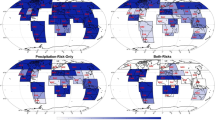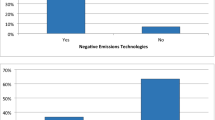Abstract
Solar radiation management (SRM) could provide a fast and low-cost option to mitigate global warming, but can also incur unwanted or unexpected climatic side-effects. As these side-effects involve substantial uncertainties, the optimal role of SRM cannot be yet determined. Here, we present probabilistic emission scenarios that limit global mean temperature increase to 2 °C under uncertainty on possible future SRM deployment. Three uncertainties relating to SRM deployment are covered: the start time, intensity and possible termination. We find that the uncertain SRM option allows very little additional GHG emissions before the SRM termination risk can be excluded, and the result proved robust over different hypothetical probability assumptions for SRM deployment. An additional CO2 concentration constraint, e.g. to mitigate ocean acidification, necessitates CO2 reductions even with strong SRM; but in such case SRM renders non-CO2 reductions unnecessary. This illustrates how the framing of climatic targets and available mitigation measures affect strongly the optimal mitigation strategies. The ability of SRM to decrease emission reduction costs is diminished by the uncertainty in SRM deployment and the possible concentration constraint, and also depends heavily on the assumed emission reduction costs. By holding SRM deployment time uncertain, we also find that carrying out safeguard emission reductions and delaying SRM deployment by 10 to 20 years increases reduction costs only moderately.




Similar content being viewed by others
Notes
Climate sensitivity indicates the equilibrium temperature increase due to a doubling of CO2 concentration.
References
Aaheim A, Romstad B, Wei T, Kristjánsson JE, Muri H, Niemeier U, Schmidt H (2015) An economic evaluation of solar radiation management. Sci Total Environ 532:61–69
Bahn O, Chesney M, Gheyssens J, Knutti R, Pana AC (2015) Is there room for geoengineering in the optimal climate policy mix? Environ Sci Policy 48:67–76
Ban-Weiss GA, Caldeira K (2010) Geoengineering as an optimization problem. Environ Res Lett 5:034009
Barrett S (2014) Solar geoengineering’s brave new world: thoughts on the governance of an unprecedented technology. Revi Environ Econ Policy 8:249–269
Bickel EJ (2013) Climate engineering and climate tipping-point scenarios. Environ Syst Decis 33:152–167
Bickel JE, Agrawal S (2013) Reexamining the economics of aerosol geoengineering. Clim Chang 119:993–1006
Bickel JE, Lane L (2010) Climate engineering. In: Lomborg B (ed) Smart solutions for climate change: comparing costs and benefits. Cambridge University Press, Cambridge, pp 9–51
Bodansky D (2013) The who, what, and wherefore of geoengineering governance. Clim Chang 121:539–551
Cao L, Caldeira K (2008) Atmospheric CO2 stabilization and ocean acidification. Geophys Res Lett 35, L19609
Cooley SR, Doney SC (2009) Anticipating ocean acidification’s economic consequences for commercial fisheries. Environ Res Lett 4:024007
Ekholm T (2014) Hedging the climate sensitivity risks of a temperature target. Clim Chang 127:153–167
Ekholm T, Lindroos TJ, Savolainen I (2013) Robustness of climate metrics under climate policy ambiguity. Environ Sci Policy 31:44–52
Emmerling J, Tavoni M (2013) Geoengineering and abatement: a ‘flat’ relationship under uncertainty. FEEM Nota di Lavoro 31:2013
Goes M, Tuana N, Keller K (2011) The economics (or lack thereof) of aerosol geoengineering. Clim Chang 109:719–744
Hoegh-Guldberg O, Bruno JF (2010) The impact of climate change on the world’s marine ecosystems. Science 328:1523–1528
Kravitz B et al (2013) Climate model response from the Geoengineering Model Intercomparison Project (GeoMIP). J Geophys Res: Atmos 118:8320–8332
Moreno-Cruz JB, Keith DW (2013) Climate policy under uncertainty: a case for solar geoengineering. Clim Chang 121:431–444
Moreno-Cruz JB, Ricke KL, Keith DW (2012) A simple model to account for regional inequalities in the effectiveness of solar radiation management. Clim Chang 110:649–668
Narita D, Rehdanz K, Tol RJ (2012) Economic costs of ocean acidification: a look into the impacts on global shellfish production. Clim Chang 113:1049–1063
Ricke KL, Morgan MG, Allen MR (2010) Regional climate response to solar-radiation management. Nat Geosci 3:537–541
Robock A, Oman L, Stenchikov GL (2008) Regional climate responses to geoengineering with tropical and Arctic SO2 injections. J Geophys Res: Atmos 113, D16101
Sillmann J, Lenton TM, Levermann A, Ott K, Hulme M, Benduhn F, Horton JB (2015) Climate emergencies do not justify engineering the climate. Nat Clim Chang 5:290–292
Smith AE (2010) Climate engineering: alternative perspective. In: Lomborg B (ed) Smart solutions for climate change: comparing costs and benefits. Cambridge University Press, Cambridge, pp 62–73
Smith SJ, Rasch PJ (2013) The long-term policy context for solar radiation management. Clim Chang 121:487–497
Tilmes S, Müller R, Salawitch R (2008) The sensitivity of polar ozone depletion to proposed geoengineering schemes. Science 320:1201–1204
Tilmes S et al (2013) The hydrological impact of geoengineering in the Geoengineering Model Intercomparison Project (GeoMIP). J Geophys Res: Atmos 118:11,036–11,058
van Vuuren DP, Stehfest E (2013) If climate action becomes urgent: the importance of response times for various climate strategies. Clim Chang 121:473–486
Vaughan NE, Lenton TM (2011) A review of climate geoengineering proposals. Clim Chang 109:745–790
Vaughan NE, Lenton TM (2012) Interactions between reducing CO2 emissions, CO2 removal and solar radiation management. Phil Trans R Soc A 370:4343–4364. doi:10.1098/rsta.2012.0188
Wigley TML (2006) A combined mitigation/geoengineering approach to climate stabilization. Science 314:452–454
Williamson P, Turley C (2012) Ocean acidification in a geoengineering context. Philos Trans R Soc A Math Phys Eng Sci 370:4317–4342
Wright MJ, Teagle DAH, Feetham PM (2014) A quantitative evaluation of the public response to climate engineering. Nat Clim Chang 4:106–110
Acknowledgments
This research has been done in the project STARSHIP (Decision No. 140800 for VTT, No. 140867 for FMI) and under the Academy Research Fellow position of Korhonen (Decision No. 250348), funded by the Academy of Finland.
Author information
Authors and Affiliations
Corresponding author
Electronic supplementary material
Below is the link to the electronic supplementary material.
ESM 1
(PDF 153 kb)
Rights and permissions
About this article
Cite this article
Ekholm, T., Korhonen, H. Climate change mitigation strategy under an uncertain Solar Radiation Management possibility. Climatic Change 139, 503–515 (2016). https://doi.org/10.1007/s10584-016-1828-5
Received:
Accepted:
Published:
Issue Date:
DOI: https://doi.org/10.1007/s10584-016-1828-5




